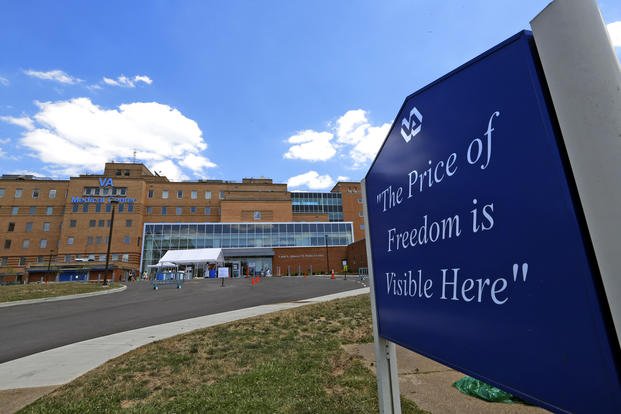

The opinions expressed in this op-ed are those of the authors and do not necessarily reflect the views of Military.com. If you would like to submit your own commentary, please send your article to [email protected] for consideration.
Faithfully following orders from President Donald Trump’s Department of Government Efficiency (DOGE) office, VA Secretary Doug Collins has announced that he will soon fire tens of thousands of employees at the Veterans Health Administration (VHA). He claims the system is too wasteful, inefficient and costly, and that the private-sector Veterans Community Care Program (VCCP), established under the VA MISSION Act of 2018, is both more cost effective and comparable in quality.
That’s just not true. VHA health care is, on average, less costly, less wasteful and of higher quality and value than private-sector alternatives. Strengthening — not decimating — in-house VHA staffing and infrastructure represents the more fiscally responsible use of taxpayer dollars. It’s also what the majority of the 9 million veterans it serves want.
When veterans are referred to outside providers through the VCCP, they enter, what Sen. Bill Cassidy (R-La.) accurately described at a June 2023 congressional hearing, as the perfect environment for unnecessary use of high-cost tests, procedures and extra appointments — all billable to the government.
Studies comparing care delivered for a multitude of conditions within and outside the VHA confirm that type of private-sector waste. When ambulances randomly transported veterans to either VHA or private emergency departments, private care cost 21% more — primarily due to unnecessary electrocardiograms, inpatient admissions, and evaluation and management services with higher reimbursement rates. Diabetic veterans rack up greater costs in the VCCP, largely from increased inpatient expenses and prescription drugs. Low-risk prostate cancer patients in the VCCP are twice as likely as those in the VHA to receive unneeded surgery or radiation, costly procedures that also carry significant risks. The private sector performs more “guideline discordant,” “questionable” and “low-value” tests than the VHA, which then lead to more unnecessary services downstream, higher health-care costs and potential harm to the patient.
Overuse of neuroimaging for headache and peripheral neuropathy is far more common in the private sector than the VHA. Veterans referred to the VCCP for other imaging are more apt to have pricey MRIs than less expensive CT scans and X-rays. Even for something as straightforward as sleep apnea testing, VCCP providers are nine times more likely than their VHA counterparts to use expensive lab-based tests instead of cost-effective home alternatives.
The explanation is simple: With lax oversight, private-sector, fee-for-service incentives drive overtreatment and profit-seeking that isn’t permitted in the VHA.
Collins — and Congress — should pay attention not only to wasteful expenditures, but also health outcomes. A growing body of research shows that, on average, veterans die at higher rates within 30 days of hospital admission when treated in the private sector across numerous conditions, including angina, stroke and heart failure, emergency care and COVID-19. Two-year survival is better for VHA than VCCP veterans who initiate chronic dialysis. VHA patients fare as good or better for inpatient and outpatient care as well, including for stroke, COPD, headaches, diabetes, depression, post-traumatic stress disorder, hypertension, urinary tract infections, knee arthroplasty and myocardial infarction medication.
To be fair, there are a few studies where private hospital care was less expensive — for six acute conditions in one study, knee arthroplasties and cataract surgeries in another, and coronary artery bypass graft procedures in a third. But these are more the exception than the rule.
What makes VHA care generally more effective?
The “VA Advantage,” as researchers call it, stems from superior care coordination and information systems tailored specifically for veterans’ complex needs. VHA providers are required to learn about the conditions — military sexual trauma and toxic exposures, for example — from which many veterans suffer. Research shows private providers frequently fail to deliver evidence-based treatments for common veteran conditions such as PTSD and depression.
Because 100% of their patients are veterans, VHA providers have accumulated specialized expertise in veterans’ problems, as well as in military culture. That simply doesn’t exist in the private sector, where veterans make up less than 5% of the patient population.
Private networks don’t match the VHA’s team-based approach, which gives vets easy access to doctors, psychologists, pharmacists, dieticians and social workers under one roof. The VHA’s one-stop integrated care reduces logistical burdens that veterans bear when they seek care across a maze of multiple private-sector facilities.
Secretary Collins’ proposed workforce reduction threatens all of this. Community care has an important role to play, but, by design, as a supplement when VHA cannot furnish timely or conveniently located services.
Before making drastic VHA cuts based on misguided assumptions, the secretary must confront the evidence: Slashing VHA staff and infrastructure will harm veterans while increasing costs to taxpayers. That’s not fiscal “efficiency”; it’s a betrayal of our sacred obligation to those who served.
Russell B. Lemle and Suzanne Gordon are senior policy analysts at the Veterans Healthcare Policy Institute, a nonprofit, nonpartisan think tank.
